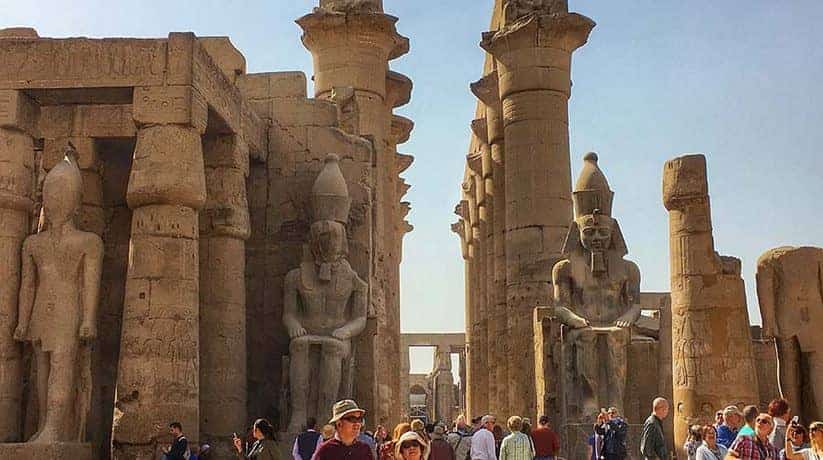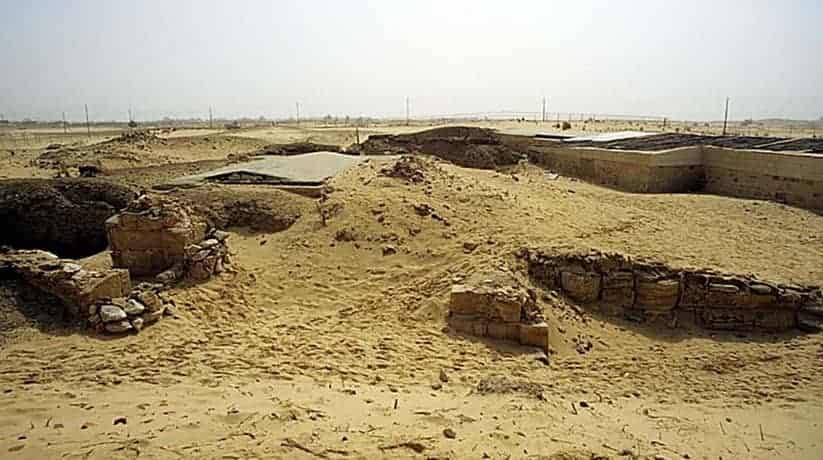Egypt temples information, tours, prices and online booking
Egypt temples in fact are the most important sites in the entire Ancient Egypt. In fact, Egypt temples are the most popular attractions for tourists from worldwide. Prepare to be blown away by the magnificence of these temples. They are undisputedly one of the world’s most breathtaking monuments, and Egypt’s second most visited touristic site, the Pyramids of Giza being on the top of the list. The relocation of the temples was a historic event in the 1960’s. At that time, the temples were threatened by submersion in Nasser’s Lake when the High Dam was constructed. The Egyptian government with the support of UNESCO launched a world wide appeal to save these colossal landmarks. They were successfully dismantled and relocated to a spot 60 meters above the cliff where they had been initially built.
The more famous of the two temples is dedicated to Ramses II and the smaller one to his favorite wife Nefertari. They were both built by Ramses II in the 13th century BC. The Temple of Amada, the oldest Egyptian temple in Nubia, was first constructed by pharaoh Thutmose III of the 18th dynasty and dedicated to Amun and Re-Horakhty. His son and successor, Amenhotep II continued the decoration program for this structure. Amenhotep II’s successor, Thutmose IV decided to place a roof over its forecourt and transform it into a pillared or hypostyle hall. During the Amarna period, Akhenaten had the name Amun destroyed throughout the temple but this was later restored by Seti I of Egypt’s 19th dynasty. Various 19th dynasty kings especially Seti I and Ramesses II also “carried out minor restorations and added to the temple’s decoration.”
Further information:
The stelas of the Viceroys of Kush Setau, Heqanakht and Messuy and that of Chancellor Bay describe their building activities under Ramesses II, Merneptah and Siptah respectively. The Greco-Roman Temple of Dakka, dedicated to Thoth, the god of wisdom. It was initially a small one-room shrine or chapel, first begun in the 3rd century BC by a Meroitic king named Arqamani (or Ergamenes II) in collaboration with Ptolemy IV who added an antechamber and a gate structure. Ptolemy IX “subsequently enlarged the temple by adding a pronaos with two rows of probably three columns.” During the Roman period, the Emperors Augustus and Tiberius further enlarged the structure with “the addition, at the rear, of a second sanctuary as well as inner and outer enclosure walls with a large pylon.
The sanctuary contained a granite naos. The Temple of Dakka was transformed into a temple fortress by the Romans and surrounded by a stone wall, 270 by 444 meters long, with an entrance along the Nile. The Temple of Derr or El-Derr is a speos or rock-cut Egyptian temple built by pharaoh Ramesses II in Lower Nubia. It is the only rock-cut temple in Nubia which was constructed by this pharaoh on the right (or east) bank of the Nile and used to stand at el-Derr.] The temple’s unique position “was probably because the river on its approach to the Korosko bend flows in an ‘unnatural’ southeasterly direction.” The Derr structure was known in ancient times as ‘The Temple of Ri’amsese-meryamun [Ramesses II] in the Domain of Re’ and was dedicated to the god Ra-Horakhty.
More information about Egypt temples:
Walk along an imposing stone causeway that leads from the banks of the lake to the first pylon of the temple, pass a colonnaded court and into the eight columned hypostyle hall. Note the hieroglyphs and the reliefs of Greek pharaohs paying homage to Ancient Egyptian deities. Look for Mandulis, the god clad in the vulture feathered cloak. Built during the late Ptolemaic period and completed during the reign of the Roman emperor Augustus, the Temple of Kalabsha was dedicated to the Nubian god called Mandulis. Dedicated to Sobek and Horus the Elder, the Temple of Kom Ombo: has two identical entrances, hypostyle halls and sanctuaries. The symmetry of the temple layout is a tribute to the mythical link the two gods shared.
Built on an outcrop at a bend in the Nile where crocodiles used to gather in ancient times, the temple is a testament to the importance Ancient Egyptian priests placed in the natural cycles and crocodiles of the Nile. Meharakka Temple was build under Roman rule. The temple was not finished, but is special because it has the only spiral staircase in any ancient Egyptian structure. It was dedicated to Serapis, the Alexandrian god. This god was introduced in Egypt in Ptolemaic times, and is a fusion of the Egyptian Gods Osiris and Apis and the Greek gods Zeus and Aesculape. Dedicated to the goddess Isis, the Temple of Philae is located in a beautiful setting, landscaped to match the original site of the temple when it was relocated by UNESCO after the building of the Aswan Dam threatened the site.
Further details:
The temple has several shrines and sanctuaries such as Trajan’s Kiosk or Pharaoh’s Bed. Visit the temple at night to attend the Sound and Light Show. Walk by several Roman kiosks, pass through the colossal gateway of Domitian and Trajan that is surrounded by a massive mud-brick enclosure and enter into the cavernous hypostyle hall of Tiberius. Visit Dendera Temple, the best preserved temple in Egypt. See vivid scenes that depict the Roman emperor Trajan paying homage to the Ancient Egyptian goddess Hathor and other mythical reliefs that adorn this gorgeous Graeco-Roman temple. Located beneath massive cliffs near the west bank of the Nile, the Mortuary Temple of Hatshepsut, also known as Deir el Bahri, is dedicated to Amon-Ra, the sun god.
Designed by an architect named Senemut, the temple is unique because it was designed like classical architecture. Note the lengthy, colonnaded terrace some of which are 97 ft high, pylons, courts, and hypostyle hall. Inside you’ll see the sun court, chapel and sanctuary. Temple reliefs depict the tale of the divine birth of Hatshepsut and trade expeditions to the Land of Punt (a reference to modern Somalia or the Arabian Peninsula). The well preserved Ptolemaic Temple of Horus is the second biggest temple in Egypt. Second only to the Temple of Karnak in sheer size, the temple was one of the last attempts by the Ptolemaic dynasty at building in the style and grandeur of their predecessors. Construction on the site took about 200 years. Well preserved hieroglyphs have shed light on the practices of the cult of Horus and associated temples.
Further details about Egypt temples:
The temple is believed to have been built on the site of the great Horus-Seth battle. The Karnak Temple Complex is home to three main temples, several smaller enclosed temples, and a number of outer temples – combining the achievements of many generations of ancient builders over a period of 1500 years. Around thirty different pharaohs contributed to the building process of this site, enabling it to reach a size, complexity and diversity not seen elsewhere. It was after all the New Kingdom’s most sacred site. Dedicated to the ram-headed creator god, the Graeco-Roman Temple of Khnum was built during the reign of the Roman emperor Claudius. All that remains of the temple is the hypostyle hall, a roof supported by 24 columns ornately decorated with scenes of the countryside and hymns to Khnum, was excavated in the 1840s.
Note the Roman floral and celestial scenes carved alongside hieroglyphs depicting temple rituals. The Temple of Luxor is a must see site on any trip to Egypt; it is a testimony to the history of the continuous history of Egypt, beginning from the 18th dynasty of Ancient Egyptian rule to the 14th century AD when a mosque was built in the complex to commemorate Abu Al-Haggag, who is responsible for bringing Islam to Luxor. Many pharaohs played a part in building this temple over the years including Tutankhamen, Hatshepsut, Ramses II, and Amenhotep III; as you walk through the temple you can see the contributions of each one usually where you find statues and images of them carved in the walls. Located 4 km east of the present town of Siwa Oasis, the Temple of the Oracle is believed to have housed the famous Greek oracle of Jupiter Amun, to which Alexander the Great headed directly when he came to Egypt for the first time in 331 BC.
More information:
Reputedly, it is believed that the Macedonian leader asked the oracle if he was going to “rule the world,” legend has it that the answer was “yes, but not for very long.” The temple has a great vestibule and forecourt. The Temple of Abydos is located to the west of El-Baliana, which is a town in Sohag Governorate. In ancient times it was called Abdu, and the Greeks called it Abydos. Abydos, the 8th province in ancient Egypt, this area is considered to be amongst the most famous archaeological sites. It was the city were Menna, the unifier of upper and lower Egypt came from and from the 11th Dynasty onwards, a burial in Abydos was the ultimate wish and honor for any local to have. In Abydos, many tombs were found belonging to the 1st and 2nd Dynasties. Also, many Kings have built Temples here, including King Pepi I, King Ahmose I, King Seti I and King Ramses II.





























